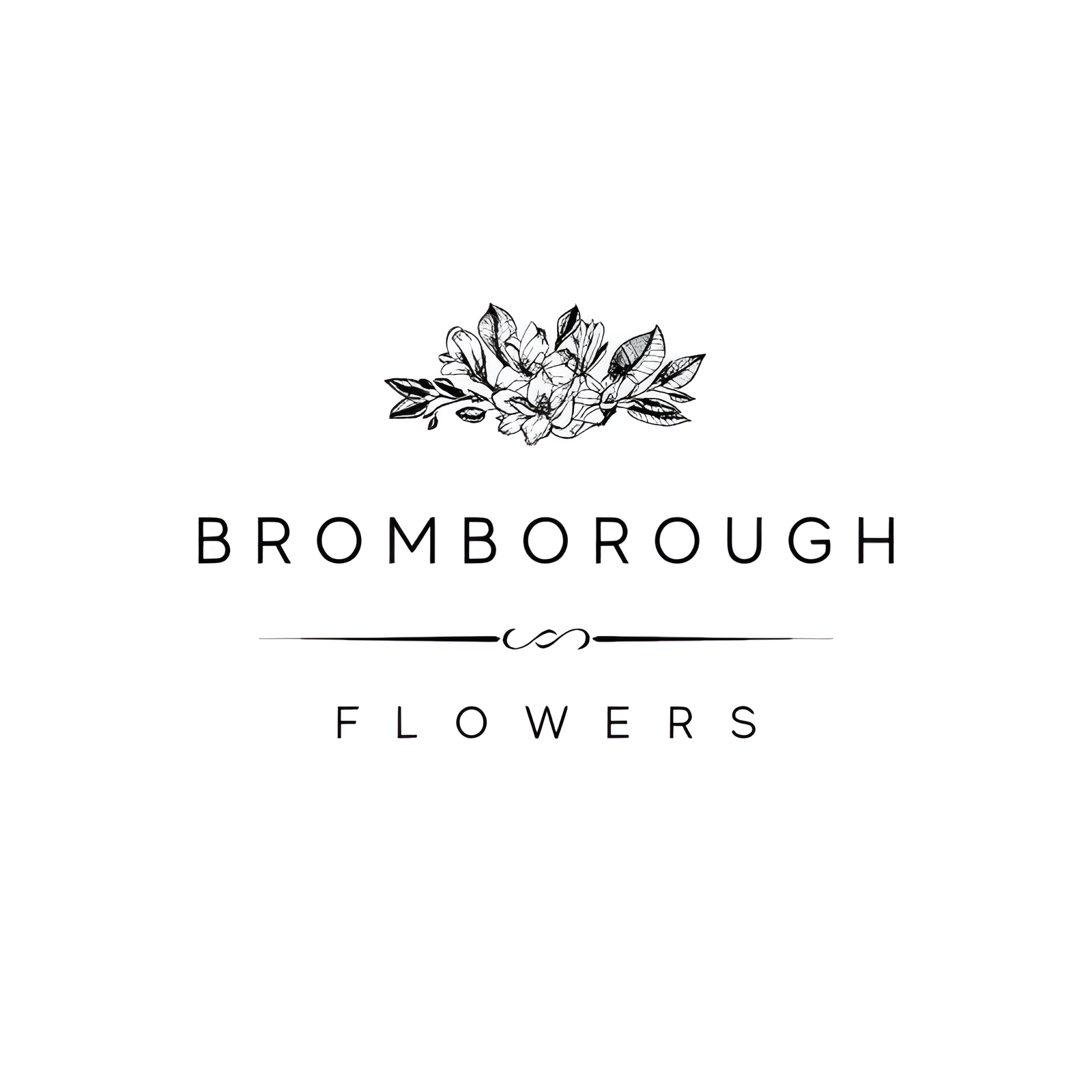Freesias, adored for their delicate fragrance and enchanting simplicity, embody an ideal choice for wedding florals, symbolizing purity, innocence, and joy. Originating from South Africa, these trumpet-shaped blooms are available in a spectrum of colors and thrive year-round, making them a versatile addition to any bridal arrangement. Their cultural significance and aromatic allure lend themselves perfectly to bouquets, boutonnieres, and centerpieces. As we explore the multifaceted appeal of freesias, each aspect—from their botanical origins to their symbolic meanings—reveals why they are celebrated in matrimonial ceremonies.
Flower Overview
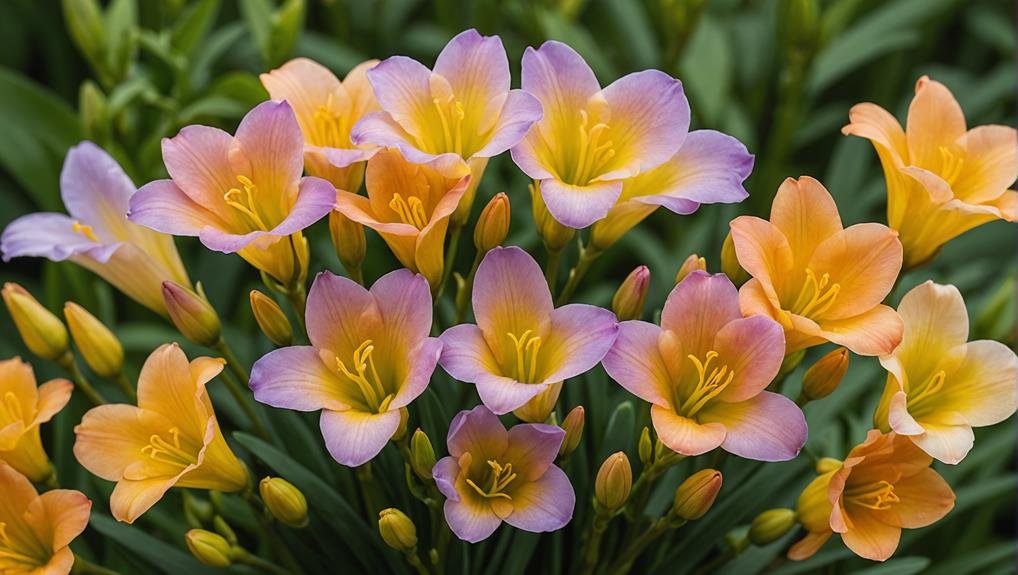
Freesias are elegant flowers, mainly available in shades of white and green, and are renowned for their delicate, loose stems. These flowers have a refined simplicity, making them a popular choice for various formal events, particularly weddings. White freesias, in particular, are celebrated for their pristine appearance, which symbolizes purity and grace. Their understated elegance allows them to blend seamlessly into assorted floral arrangements, adding a touch of sophistication without overshadowing other flowers.
In addition to their visual appeal, freesias are also notable for their strong and pleasant fragrance. This distinctive scent is a key reason why they are frequently incorporated into wedding bouquets and boutonnieres. The aroma of white freesias can create a memorable sensory experience for guests, enhancing the overall ambiance of the occasion.
However, it is crucial to keep in mind that the strong scent of freesias can occasionally trigger allergies or migraines in some individuals. When planning a wedding or event, it is advisable to be attentive to guests’ sensitivities to ensure everyone’s comfort.
Despite this consideration, the timeless beauty and aromatic allure of white freesias make them a favored choice for elegant and refined floral arrangements.
Physical Description
Boasting elegant simplicity, these flowers typically feature slender, loose stems and delicate, trumpet-shaped blooms. Freesia, a popular choice for wedding flowers, presents a refined yet understated charm that enhances any bridal arrangement. The stems, while not overly rigid, possess a certain fluidity that adds an element of natural grace to bouquets and boutonnieres alike.
The blooms of freesia are particularly remarkable for their visual appeal and aromatic presence. Each flower displays a classic, trumpet-like shape that exudes both delicacy and sophistication, making it an ideal selection for wedding flowers. The blossoms tend to cluster along one side of the stem, creating a pleasing asymmetry that adds depth and interest to floral designs.
In addition to their visual attributes, freesia flowers are renowned for their strong, captivating scent. This fragrance, while enchanting to many, can be a double-edged sword; individuals sensitive to strong smells might find the aroma overwhelming, potentially triggering allergies or migraines. Despite this, freesia remains a top choice in wedding floristry due to its aesthetic and olfactory virtues.
Available Colour Varieties
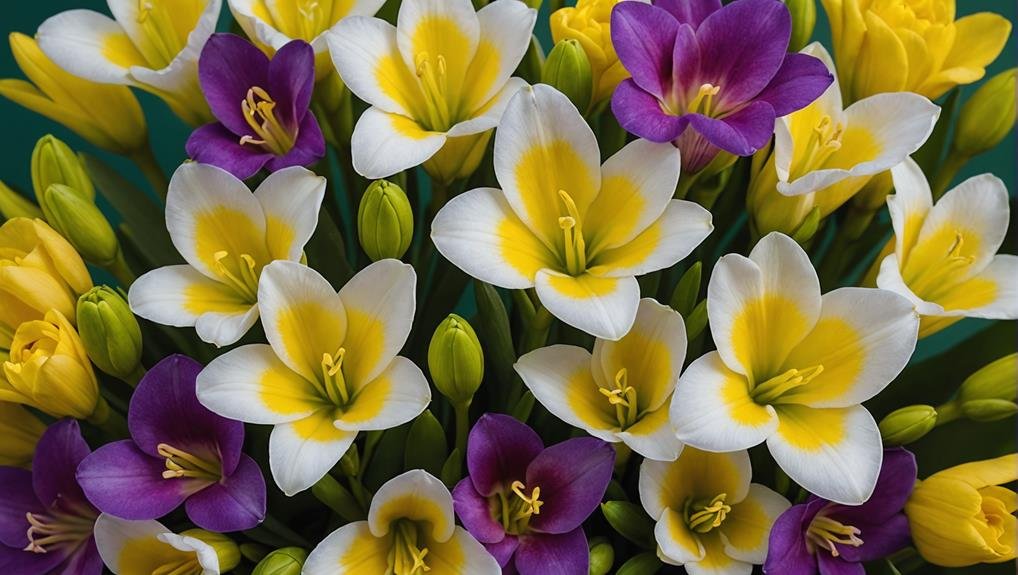
A diverse palette of colors is available for freesia flowers, including hues such as white, yellow, pink, red/orange, and purple. These versatile blooms are an excellent choice for wedding table arrangements and bridal bouquets, offering both aesthetic beauty and symbolic meanings.
White freesias, for instance, represent purity and innocence, fitting seamlessly into wedding themes.
Yellow and pink freesias are often chosen for their delicate pastel tones, symbolizing joy, harmony, and motherly love. These shades can add a soft, romantic touch to your wedding table settings.
Red/orange freesias are more vibrant, symbolizing struggle and vitality, making them considering for bold, eye-catching floral displays.
Purple freesias add a regal and sophisticated element to the decor.
With over 1,400 crossbred species, the options are nearly endless, allowing you to find the perfect shade to complement your wedding color scheme.
Here are three key points to keep in mind when choosing freesia colors for your wedding:
- Theme Alignment: Ensure the colors match your overall wedding theme.
- Symbolism: Choose hues that convey desired emotions or messages.
- Variety: Utilize the vast range of freesia colors to create dynamic and visually appealing arrangements.
Latin Name and Taxonomy
The Latin name for freesia, derived from the botanist Friedrich H.T. Freese, underscores its historical and botanical importance. Named in honor of Freese by his friend and fellow botanist Christian P. Ecklon, Freesia is a tribute to the rich history of botanical nomenclature. The genus Freesia belongs to the family Iridaceae and is classified under the order Asparagales, which encompasses a diverse range of flowering plants.
Freesias are herbaceous plants, comprising around 14 known species, each contributing to the genus’s distinctive characteristics. These zygomorphic flowers, exhibiting bilateral symmetry, are distinguished by their graceful and balanced floral structure. Such symmetry not only enhances their aesthetic appeal but also plays a vital role in their pollination mechanisms.
Understanding the taxonomy of Freesia is important for appreciating its place within the botanical world. The genus’s placement within the Iridaceae family highlights its relation to other ornamental plants, such as irises and gladioli. This connection underscores the diversity and evolutionary significance of the family.
Geographical Origins
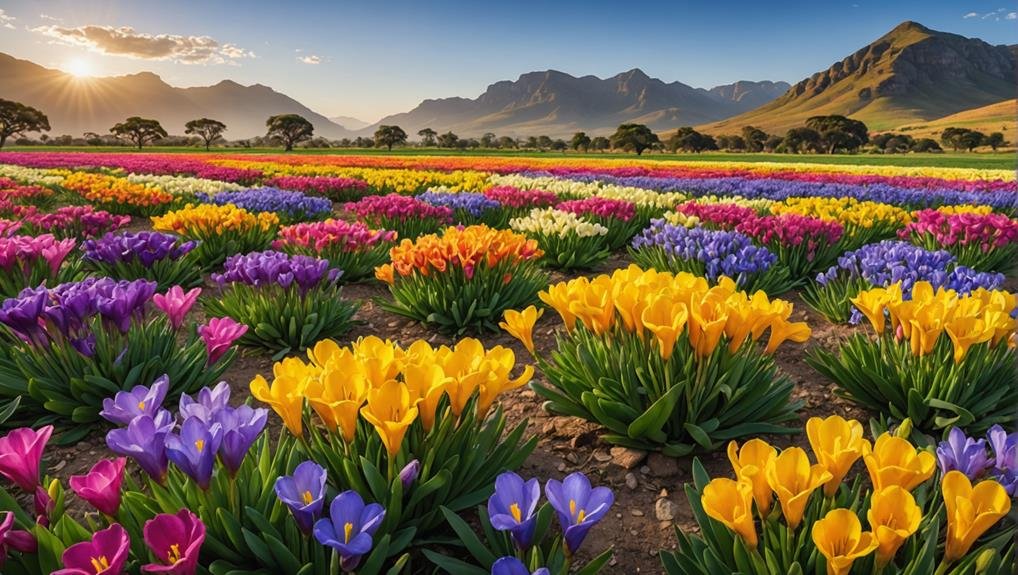
Originating from the diverse landscapes of South Africa, freesias have enthralled botanists and flower enthusiasts alike with their exotic charm and unique fragrance. These delicate, trumpet-shaped flowers trace their roots specifically to the Cape Province and the eastern regions of South Africa. Known for their striking beauty and aromatic presence, freesias belong to the Iris family and were named after German botanist Friedrich H.T. Freese by Christian P. Ecklon, a fellow botanist who discovered them.
The geographical origins of freesias can be summarized in three key points:
- Native Habitat: Freesias thrive in the varied climates of South Africa, particularly in the Cape Province and eastern regions, where they grow naturally.
- Global Cultivation: Despite their South African origins, freesias have been cultivated worldwide, adapting to various climates and becoming a staple in gardens and floral arrangements.
- Botanical Significance: The discovery and naming of freesias highlight their importance in botanical history, showcasing the rich biodiversity of South Africa.
The enduring popularity of freesias in weddings and special occasions can be attributed to their elegant appearance and enchanting fragrance, making them a cherished choice for floral arrangements globally.
Season Availability
While freesias captivate with their rich South African heritage, their availability throughout the year further enhances their appeal for weddings and events.
Freesias are a versatile floral choice, thriving in moderate climates worldwide and thereby ensuring consistent availability regardless of the season. This year-round accessibility makes them a popular option for various wedding themes, including the ever-popular summer wedding.
Seasonal variations do exist, however, concerning color availability. Different freesia colors may be more readily available at certain times of the year due to specific growing conditions. For example, some hues might be more abundant in spring, while others peak in autumn. Despite these fluctuations, the global cultivation and distribution of freesias generally guarantee a steady supply.
Weather conditions and cultivation practices can also impact the availability of freesias. Florists and suppliers adjust their offerings based on these factors, providing a variety of colors throughout the year. Thus, whether planning a winter or summer wedding, couples can find freesias to match their color palette and aesthetic preferences.
This consistent availability underscores freesia’s enduring popularity as a wedding flower, adaptable for any season or event.
Growing Conditions
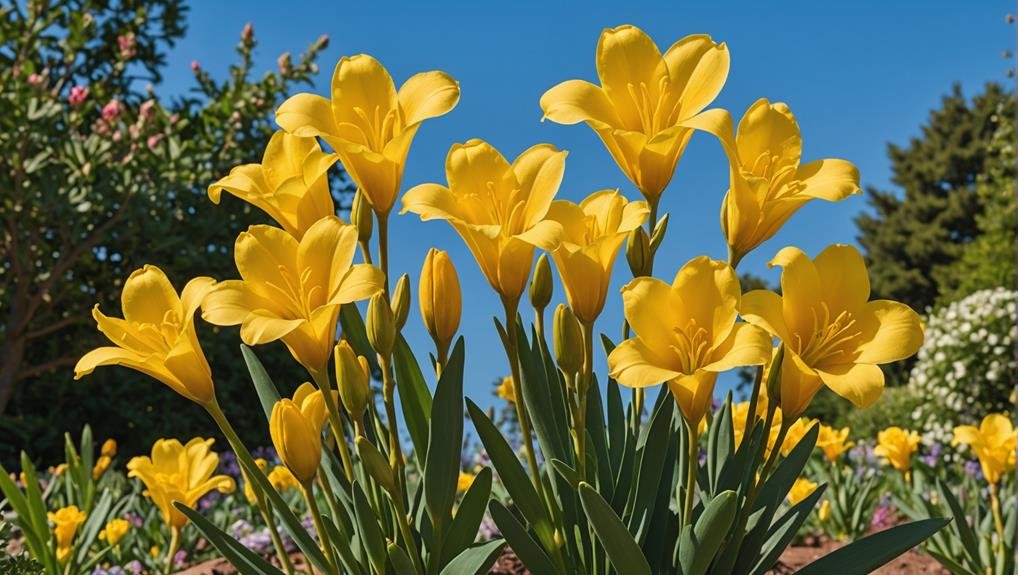
To cultivate freesias successfully, gardeners must provide well-drained soil and ample sunlight, with ideal temperatures ranging from 55-70°F. These conditions are essential for the vibrant blooms often featured in wedding venues.
Ensuring the soil is well-drained prevents waterlogging, which can hinder growth and cause rot. Freesias also require regular watering, especially during their spring and summer growing seasons, to maintain optimal moisture levels.
When planting freesia bulbs, follow these guidelines for best growth:
- Depth and Spacing: Plant bulbs 2-4 inches deep and 2-4 inches apart, ensuring the pointed end faces up.
- Indoor vs. Outdoor: Freesias can be grown outdoors in USDA hardiness zones 9-11 or indoors as potted plants, providing flexibility for various climates and settings.
- Fertilization: Use a balanced fertilizer every 2-4 weeks during the active growth period to promote healthy development.
Cultural Significance
Freesias hold a prominent place in wedding traditions due to their symbolism of friendship, innocence, and trust. These delicate blooms are often chosen for their profound cultural significance, which resonates deeply with the essence of matrimonial ceremonies. In the Victorian language of flowers, freesias were emblematic of trust, making them ideal for occasions that celebrate the union and promise between partners.
In the United States, freesias are particularly esteemed as symbols of trust during 7th wedding anniversaries, reflecting enduring commitment and mutual respect in a relationship. This enduring symbolism is further amplified across various cultures, where freesias are cherished gifts aimed at altering moods and evoking feelings of trust and sincerity.
Furthermore, freesias’ cultural significance is enriched by their representation in numerology. They are associated with selflessness and obligation, making them a meaningful addition to wedding arrangements. These attributes underscore the importance of reliability and dedication in marital bonds, enhancing the overall sentiment of trust within the ceremony.
Typical Use in Weddings
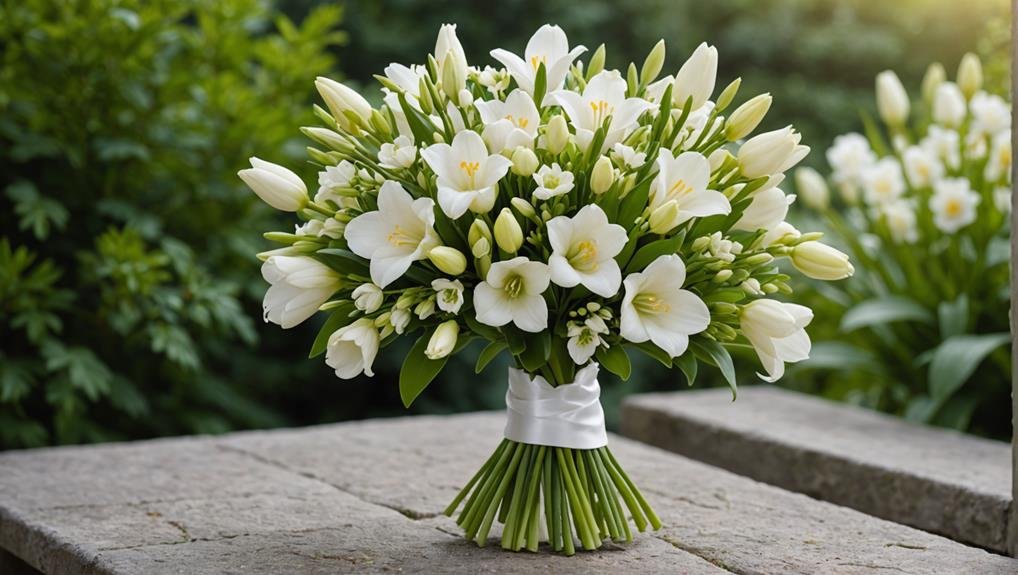
Renowned for their delicate appearance and sweet fragrance, freesias are a popular choice in wedding bouquets, boutonnieres, and centerpieces. Their versatility allows them to complement various wedding themes and color schemes, making them a favorite among brides and wedding planners alike. Freesias symbolize purity, innocence, trust, and friendship, which adds a layer of meaning to wedding ceremonies.
In the context of the wedding party, freesias can be used in several essential ways:
Bridal Bouquets:
Brides often opt for white freesias to symbolize purity and commitment. These flowers can be the main focus or act as a delicate accent in mixed bouquets.
Boutonnieres:
Grooms and groomsmen frequently wear freesias as boutonnieres. Their compact size and pleasant fragrance make them an excellent choice to complement formal attire.
Centerpieces:
Freesias are also popular in table centerpieces, adding elegance and a sweet scent to the reception. Their ability to blend well with other flowers and greenery makes them versatile for various table arrangements.
Alternative Flower Types
While freesias are a beloved choice for wedding arrangements, several alternative flower types can also bring unique charm and fragrance to your special day. Stephanotis, for example, is a popular alternative for boutonnieres, prized for its waxy white blooms and mild, sweet fragrance. This makes it an excellent option for loved ones who may be sensitive to strong scents.
Gardenias are another excellent choice, known for their elegant, creamy white petals and strong, sweet scent. Their luxurious appearance makes them perfect for adding a touch of sophistication to any wedding arrangement. Lilies of the valley, with their delicate, bell-shaped flowers and fresh, floral fragrance, are particularly well-suited for bridal bouquets, offering a sense of purity and simplicity.
Orchids are also a versatile alternative, available in a wide range of colors and shapes, and can be used to create striking, modern arrangements that stand out.
| Flower Type | Key Characteristics |
|---|---|
| Stephanotis | Waxy white blooms, mild sweet fragrance |
| Gardenias | Creamy white petals, strong sweet scent |
| Lilies of the Valley | Delicate bell-shaped flowers, fresh fragrance |
| Orchids | Various colors and shapes, modern appeal |
These alternatives can enhance your wedding’s floral arrangements, ensuring each bouquet and boutonniere captures the essence of your special day.
